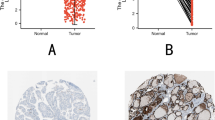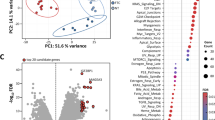Abstract
Peroxisome proliferator-activated receptor gamma (PPARγ) has previously been implicated in the pathogenesis of follicular thyroid carcinoma (FTC), where a translocation with PAX8 has been reported in some 50% of tumors in three small series. The resultant fusion protein inhibits normal PPARγ function by a dominant-negative mechanism. In a series of 19 FTCs, we identified this translocation in only two tumors (10.5%). However, microarray analysis and semiquantitative RT–PCR demonstrated greatly reduced PPARγ expression in 13 of 17 (76%) nontranslocation tumors. Immunohistochemical analysis of 142 thyroid tumors showed a statistically significant reduction in PPARγ immunoreactive protein, not only in FTCs but also in papillary thyroid carcinomas and Hurthle cell carcinomas. This suggests that while the overall frequency of the PAX8–PPARγ translocation in FTCs may be lower than previously thought, functional downregulation of PPARγ is a key event in multiple types of thyroid neoplasia and is a possible target for therapeutic intervention.
This is a preview of subscription content, access via your institution
Access options
Subscribe to this journal
Receive 50 print issues and online access
$259.00 per year
only $5.18 per issue
Buy this article
- Purchase on Springer Link
- Instant access to full article PDF
Prices may be subject to local taxes which are calculated during checkout


Similar content being viewed by others
References
Clay CE, Namen AM, Fonteh AN, Atsumi G, High KP and Chilton FH . (2000). Prostaglandins Lipid Mediators, 62, 23–32.
Dahia PL, Marsh DJ, Zheng Z, Zedenius J, Komminoth P, Frisk T, Wallin G, Parsons R, Longy M, Larsson C and Eng C . (1997). Cancer Res., 57, 4710–4713.
Elbrecht A, Chen Y, Cullinan CA, Hayes N, Leibowitz MD, Moller DE and Berger J . (1996). Biochem. Biophys. Res. Commun., 224, 431–437.
Grebe SKG, Mclver B, Hay ID, Wu PS-C, Maciel LMZ, Drabkin HA, Goellner JR, Grant CS, Jenkins RB and Eberhardt NL . (1997). J. Clin. Endocrinol. Metab., 82, 3684–3691.
Halachmi N, Halachmi S, Evron E, Cairns P, Okami K, Saji M, Westra WH, Zeiger MA, Jen J and Sidransky D . (1998). Genes Chrom. Cancer, 23, 239–243.
Kroll TG, Sarraf P, Pecciarini L, Chen C-J, Mueller E, Spiegelman BM and Fletcher JA . (2000). Science, 289, 1357–1360.
Marques AR, Espadinha C, Catarino AL, Moniz S, Pereira T, Sobrinho LG and Leite V . (2002). J. Clin. Endocrinol. Metab., 87, 3947–3952.
Martelli ML, Iuliano R, Le Pera I, Sama I, Monaco C, Cammarota S, Kroll TG, Chiariotti L, Santoro M and Fusco A . (2002). J. Clin. Endocrinol. Metab., 87, 4728–4735.
Nikiforova MN, Biddinger PW, Caudill CM, Kroll TG and Nikiforov YE . (2002). Am. J. Surg. Pathol., 26, 1016–1023.
Ohta K, Endo T, Haraguchi K, Hershman JM and Onaya T . (2001). J. Clin. Endocrinol. Metab., 86, 2170–2177.
Oriola J, Halperin I, Mallofré C, Muntané J, Angel M and, Rivera-Fillat F . (2001). Eur. J. Cancer, 37, 2470–2474.
Sarraf P, Mueller E, Smith WM, Wright HM, Kum JB, Aaltonen LA, de la Chapelle A, Spiegelman BM and Eng C . (1999). Mol. Cell, 3, 799–804.
Smith WM, Zhou X-P, Kurose K, Gao X, Latif F, Kroll TG, Sugano K, Cannistra SA, Clinton SK, Maher ER, Prior TW and Eng C . (2001). Hum. Genet., 109, 146–151.
Trovato M, Fraggetta F, Villari D, Batolo D, Mackey K, Trimarchi F and Benvenga S . (1999). J. Clin. Endocrinol. Metab., 84, 3235–3240.
Tung WS, Shevlin DW, Kaleem Z, Tribune DJ, Wells Jr SA and Goodfellow PJ . (1997). Genes Chrom. Cancer, 19, 43–51.
Ward LS, Brenta G, Medvedovic M and Fagin JA . (1998). J. Clin. Endocrinol. Metab., 83, 525–530.
Yeh JJ, Marsh DJ, Zedenius J, Dwight T, Delbridge L, Robinson BG and Eng C . (1999). Genes Chrom. Cancer, 26, 322–328.
Zedenius J, Wallin G, Svensson A, Bovée J, Höög A, Bäckdahl M and Larsson C . (1996). Hum. Genet., 97, 299–303.
Zhou X-P, Smith WM, Gimm O, Mueller E, Gao X, Sarraf P, Prior TW, Plass C, von Deimling A, Black PM, Yates AJ and Eng C . (2000). J. Med. Genet., 37, 410–414.
Acknowledgements
We are grateful to core facility staff at The Ohio State University for their services: Kimberley Bentley and Yiwen Liu-Stratton for microarray hybridizations, Mike Stevens and Jenny Panescu for ABI genotyping and sequencing, and Susie Jones for immunohistochemistry. MAA is supported by an Advanced Training Fellowship from the Wellcome Trust, UK. CE is a recipient of the Doris Duke Distinguished Clinical Scientist Award. This work was partially funded by National Cancer Institute Grant P30CA16058 to The Ohio State University Comprehensive Cancer Center, and generous gifts from the Abrams family and the Brown family in memory of Welton D Brown (to CE).
Author information
Authors and Affiliations
Corresponding author
Rights and permissions
About this article
Cite this article
Aldred, M., Morrison, C., Gimm, O. et al. Peroxisome proliferator-activated receptor gamma is frequently downregulated in a diversity of sporadic nonmedullary thyroid carcinomas. Oncogene 22, 3412–3416 (2003). https://doi.org/10.1038/sj.onc.1206400
Received:
Revised:
Accepted:
Published:
Issue Date:
DOI: https://doi.org/10.1038/sj.onc.1206400
Keywords
This article is cited by
-
Pax-8–PPAR-γ fusion protein in thyroid carcinoma
Nature Reviews Endocrinology (2014)
-
Novel high-affinity PPARγ agonist alone and in combination with paclitaxel inhibits human anaplastic thyroid carcinoma tumor growth via p21WAF1/CIP1
Oncogene (2006)
-
Expression profiling reveals a distinct transcription signature in follicular thyroid carcinomas with a PAX8-PPARγ fusion oncogene
Oncogene (2005)



